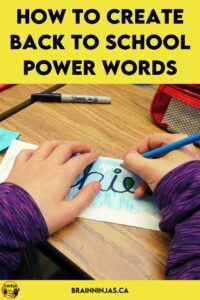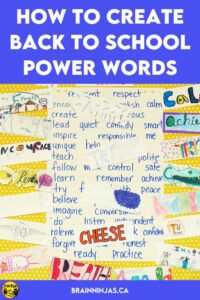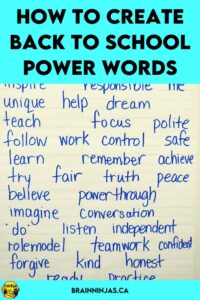
Do your students write goals? It can be an effective way to have students learn to take responsibility for their behaviour or learning. We tried something new this year. Students chose power words instead of goals.
Back to school is a great time to reflect on past years in school. It’s the right time to think about the positive changes you and your students can make. This will help you all have a wonderful year together.
Each year we try to mix up our different bulletin boards to get things started off well. One of our new favourites is to create a set of power words. It’s always the first thing we create in our classroom with each new group of students.
What is a Power Word?

Instead of a motto or a goal, choose one word. This one word can be a mantra, saying or goal and can be a powerful way to realign yourself with your priorities. Over the years we’ve had power words to help us stay focused on our goals. Some of our words have been: jump, fearless, simplify, reach, grow, and cheese (that one was a reminder to have fun more often).
This is the perfect activity to use on the first day of school or after a long break. If you’re looking for other activities for back to school try this post: Ten Things We Do on the First Day Back to School.
How to Get Your Students Thinking About Power Words

We started with a classroom brainstorming session where we listed as many power words as possible.
There are no real rules about what is or is not a power word. Students are welcome to include anything they feel would benefit them.
There were a few examples on the list when we started so students could gain a sense of what types of words might work. After fifteen minutes we ran out of room on our chart paper. This meant our students were ready to pick their own words.
When you’re collecting words with your class, all words should be included. Don’t judge any words but allow students to talk about what the word means to them if students want to share.
Some of the most common words we hear year after year are: achieve, believe, focus, calm, breathe (though lots of kids forget the e), best, try or remember.
Some of our favourite less common words have been: armpits, sit, dance and vegan.
What Do You Do With the Power Words?

We asked our students to think about how the word looks to them when they see it in their head. We didn’t mean how it looked as a picture, but did they see the word with fat, bold letters, or swirly, curly letters?
Students were given half of an 8×11 sheet of paper folded lengthwise and were asked to write out their power word in an interesting way your students coloured and drew and made their words their own.
You could definitely make your class’s words bigger or smaller, but this was the size chose because we knew they could fit on our bulletin board.
Ninja Note: Before your students get too far, check their spelling. We had a lot of acheiving and beleeving one year.
This project can easily be made digital. Using Google Slides or Google Drawings, students can set up their page to be 11 inches by 4.25 inches. They can use shapes, fonts and colours to decorate their word and if you have a colour printer, you can print them out to add to a bulletin board.
You can also make the words into a full art project using art supplies like paint. Wait! Too messy for you? Read this post: Are You Avoiding Teaching Art?
What to Do With the Power Words Once They’re Made

Each student was photographed with their power word. We printed these in colour on a full page size and students placed these in the front of their daily work binder.
It was a constant reminder to aim to live up to their power word.
We also created a display in our classroom where we hung all of our power words for the entire year. It was a great conversation piece between students and guests in our classroom. Students were challenged to come up with interesting and creative words and loved the idea of making visual representations of their words. We’ve included this lesson and many more like it in our Back to School Activities Set which can be found in our TpT Store ($USD) or BN Shop ($CAN).
Another way to display the words is on your welcome bulletin board. We start off our board blank except for the word welcome which contains many different languages that also say welcome. Welcoming our students in their native languages started as a simple tradition years ago and now we have well over thirty languages included on our welcome wall.
We post the power words all around the welcome sign, and this bulletin board stays this way for the most part all year. You can get your own copy of the Multicultural Welcome Bulletin Board for free, or you can find it in our Resource Library.
Need a Virtual or Online Version?
For a virtual alternative, take photos of each of the words or have students create their words using Google Slides.
Put the images into a Google Slides presentation and share it with your students as a view only file. We also removed the opportunity to comment on it to prevent any moderating (extra work). Students can see the collection without needing the wall space for them.
We also used classroom photos and added them to a slide show at the end of the year.
Other Ways We Create Community
We work hard to build relationships with and between our students. This helps with classroom management and creates good memories for everyone.
One of our followers suggested a few books that work well with this activity. Check out Tomorrow, I’ll be Brave and Tomorrow, I’ll Be Kind by Jessica Hische.
You might be interested in reading some of our other ideas:
Create a Culture of Community in Your Multi-Grade Classroom
How to Weave Kindness into the Classroom Every Day
Classroom Community Unit: This set of activities is a fun way for students to get to know each other. It’s important to make all of your students feel welcome. It empowers them. We encourage you to try it this year. Let us know your power words in the comments below. Find it in our TpT Store ($USD) or our BN Shop ($CAN).
Collaborative posters are another way you can get students working together. We’ll send this free welcome poster to you when you sign up for our email list. You’ll also get access to our Resource Library. If you’re already a ninja, you can find it in our Resource Library. We also have a French version.








